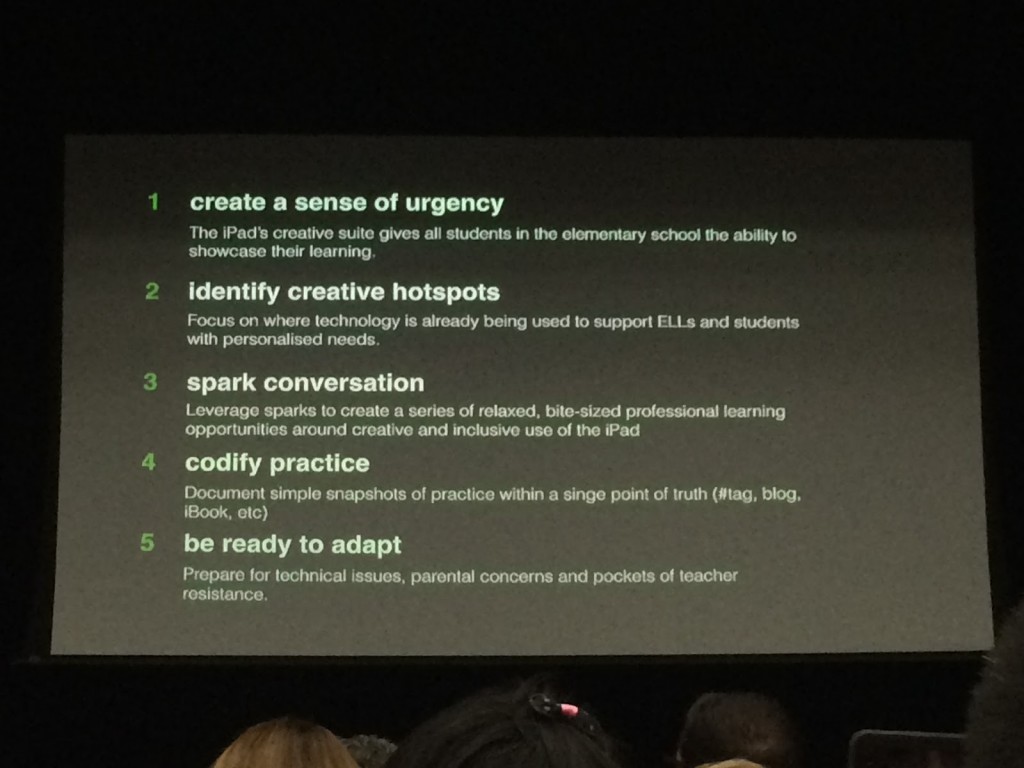Michael Boll
I just came back from an iPad conference this last weekend and one of the presenters, John Burns talked about  change management at his keynote. It was really quite interesting and wonderfully articulated five steps to managing change in an organization.
change management at his keynote. It was really quite interesting and wonderfully articulated five steps to managing change in an organization.
Conveniently, I will just run through them for this podcast. How easy!
- Create a sense of urgency. Not to the point where you scare people. Don’t say “Tech is coming and if we don’t get on board, we will all fail.” Instead let people know it is a focus moving forward and the organization is spending its energy in this direction.
- Identify creative hotspots. Loved this one! There is always great things going on in the classrooms and by spotlighting these occurrences you grant public recognition to the individuals, which inspires them to continue. More importantly, it lets others know that people like them are doing great things and they can do great things too, or at least find somebody to help them other than admin.
- Spark conversation. Good conversational opportunities at specific events often lead to “Yeah, I should do that too” statements and feelings. Have enough of these conversations and suddenly people go form should do it to actually doing it.
- Codify practice. Similar to spotlighting, let the world know of the great things going on. Thanks to the communication revolution, there is little need to only share this within your organization. Get the word out via podcasts, Twitter, conferences, etc. Nothing codifies practice like someone from the outside coming up to you and saying “wow you guys really do great things at your school.” You have to reply with “Yeah, sure!” Then you realize you better get on board if you are not already, or feel better if you have been on board.
- Be ready to adapt. Get your plan in place, but know things are going to totally mess up along the way. Plan for it; understand it is an iterative process. Having that attitude going in; just waiting for difficulties to jump in the way and resist you, gives you the sense of control needed to continue to push forward. If you don’t get any resistance, that tells you that you are not really doing something very significant anyway.

Chris
Going highbrow on this one, I like the Harvard Business Review’s piece entitled, 7 Things Leaders Do to Help People Change. Interestingly, being nice, and offering advice had no appreciable positive effects on subordinates when it came to creating a culture of change, according to the article. What do work are:
- Inspiring others.
- Noticing problems.
- Providing a clear goal.
- Challenging standard approaches.
- Building trust in your judgment.
- Having courage.
- Making change a top priority.
Please give this wonderful, succinct, insightful article a read. It may change your leadership style.
Jamie
Since Chris and Mike already covered the general perspective I’m going to talk specifically about edtech a bit since I think that is where most of the people listening are coming from. Education Week had an interesting article about why we don’t see more changes in schools with regards to education technology. They list many different reasons but there are 2 that stand out the most to me.
First, when you are trying to get people to change to a new tech tool or system I think the first thing you need to do is be very very clear about the why. Why should I put in the time to change? And there needs to be a very clear benefit to taking the time to change. Simply because it’s new and will make the school look good is never enough.
Second you need to provide training. What I learned while being a technology coach is that no matter how much training you think will be enough, people will need more. When we gave iPads out our teachers I thought that after a year or two they would be common enough that we wouldn’t need to provide training on how to use them. Nope. Each year we had more and more people interested in a 101 course on transferring data, setting up email, downloading apps and other basics that I thought we would outgrow. If you are going to truly change the way people teach, then you need to be ready to put in the time to train them in how to do it.
